Photographs: Reuters Bhupesh Bhandari in New Delhi
A recent vacation in Himachal Pradesh introduced me to the prosperity of the state.
All the three sectors -- industry, agriculture and services (tourism) -- seem to be doing well.
There are few signs of poverty and every sign of buoyant consumerism.
The traffic of trucks along the main highways is strong and the car population is dense.
One particular model that seems popular is the Nano -- red, silver and yellow.
The smallness of the car is perfectly suited for the hills, some owners said, because it is easy to park, convenient to negotiate bends, economical to run and fun to race on narrow roads.
. . .
Tata Nano's road to recovery
Image: Tata Nano on display at the 78th Geneva Car Show.Photographs: Reuters
Till a few months ago, it looked as if Tata Motors had got the Nano script all wrong. There were incidents of the car catching fire.
Many who had booked the car in April 2009 lost patience and cancelled their bookings. Word-of-mouth publicity, which can make or break any new product in India, did not favour the Nano.
Sales began to fall after peaking at 9,000 in July last year.
The lowest point came in November when the company sold only 509 pieces.
Since then, the numbers have recovered gradually.
Tata Motors sold 5,784 Nanos in December, 6,703 in January, 8,262 in February and 8,707 in March. In the whole of 2011, the company sold 70,432 Nanos, way below the Indigo (87,925) and the Indica (97,845).
. . .
Tata Nano's road to recovery
Image: The Nano is a major attraction at the symposium.Photographs: Paresh Gandhi/Rediff.com
But if the March numbers are anything to go by, the pecking order could look very different in the current financial year -- while Tata Motors sold 8,707 Nanos, it sold 7,197 Indigos and 6,937 Indicas.
There is, however, a caveat.
The Indica did below potential in 2010-11 because there was no BS-IV variant of the old Indica; now that it has been introduced, Indica numbers could rise and provide a challenge to the Nano.
But few doubt that the Nano will soon become what it was always meant to be -- the most popular car from the Tata Motors stables.
This turnaround in the car's fortune hasn't happened on its own; Tata Motors has done some serious course-correction in the last few months.
. . .
Tata Nano's road to recovery
Image: An interior view of the Nano.When the Nano was launched in 2009, Tata Motors was blas about the marketing bit. The campaign for any new product has to do two things -- inform about the new product and outline its features.
The Nano had generated so much publicity that all the marketing team had to do was highlight its features.
There was excessive reliance on the Internet for marketing; conventional marketing tools were jettisoned.
What the company didn't realise was that the market for the Nano could be away from the Internet crowd, in small towns and villages -- like those along the highway through Himachal Pradesh.
. . .
Tata Nano's road to recovery
Image: Ashok Vichare, the first owner of Nano, gets the keys from Ratan Tata.Photographs: Prasanna D Zore/Rediff
The challenge was to reach the car to these markets.
Tata Motors has, thus, set up Nano access points through its dealers.
These are like extension counters -- low-cost showrooms where anybody can see the car, test-drive it and also book it.
So far, 219 such points have been set up, and more could follow in the days to come.
The company says the experiment has worked well, though it is not known how much it contributes to the car's sales.
(Some volumes have also come from the display at the Big Bazaar stores.)
. . .
Tata Nano's road to recovery
Image: A dismantled Tata Nano at the 'Unpacking the Nano' symposium at Cornell University in Ithaca, NY.Photographs: Paresh Gandhi/Rediff.com
Sale, in the automobile market, is just half the job.
Tata Motors needs to provide buyers inexpensive spares and convenient service options. This is not something the access points can do.
The purpose will get defeated if the buyer has to drive 50 km to get his car serviced or minor faults repaired. Tata Motors seems to be aware that this could be an issue, given the brisk sales of the Nano in smaller markets.
It now wants to do what it did for the Ace -- its small truck.
Apart from the dealership network for commercial vehicles, the company has set up 600 exclusive dealerships for the Ace.
. . .
Tata Nano's road to recovery
Image: Ratan Tata (left), and Gujarat chief minister Narendra Modi at Tata Motors' Sanand plant.Photographs: Reuters
The strategy will be replicated for the Nano.
This, it believes, will make spares and service easily available to the buyers.
The other issue Tata Motors had overlooked was that the booking route gave it no knowledge of the buyers' profile.
Once open sales were started in August last year (the company began with Kerala around Onam and spread to all other states over the next six months), it realised that many of the buyers did not get a salary cheque at the end of the month -- traders, self-employed, farmers, entrepreneurs et cetera.
The assessment of their risks was not something banks and car-finance companies wanted to do.
. . .
Tata Nano's road to recovery
Image: The Tata Nano Europa car at the 79th Geneva Car Show at the Palexpo in Geneva.Photographs: Reuters
Tata Motors then brought in its finance arm, Tata Motors Finance, to help this category of buyers.
It, the company claims, now finances a large chunk of the Nanos sold.
The Nano is no longer the Rs 100,000-car it was supposed to be, though it is still the cheapest thing on four wheels.
For prospective buyers, it's still a deeply thought out decision.
To bring down the cost of ownership, Tata Motors has introduced warranty of four years on parts.
It has, at times, also thrown in freebies like Tanishq gift vouchers and accessories with the car.
With the current volumes, the Nano plant at Sanand in Gujarat is running way below capacity (250,000 per annum).
The next challenge for Tata Motors will be to take the numbers to that level.



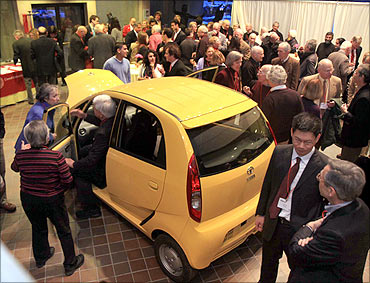
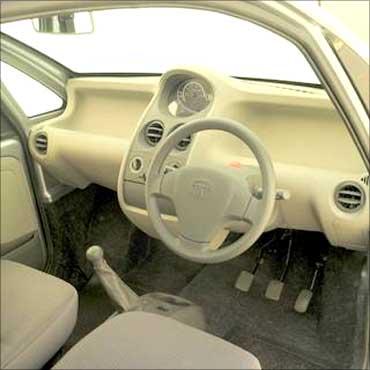
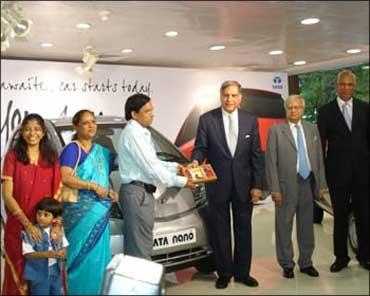

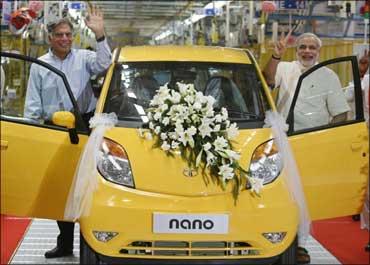
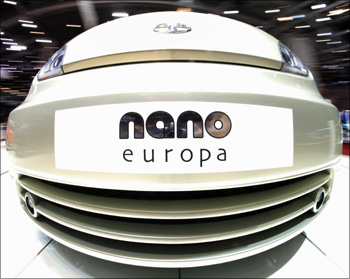

article